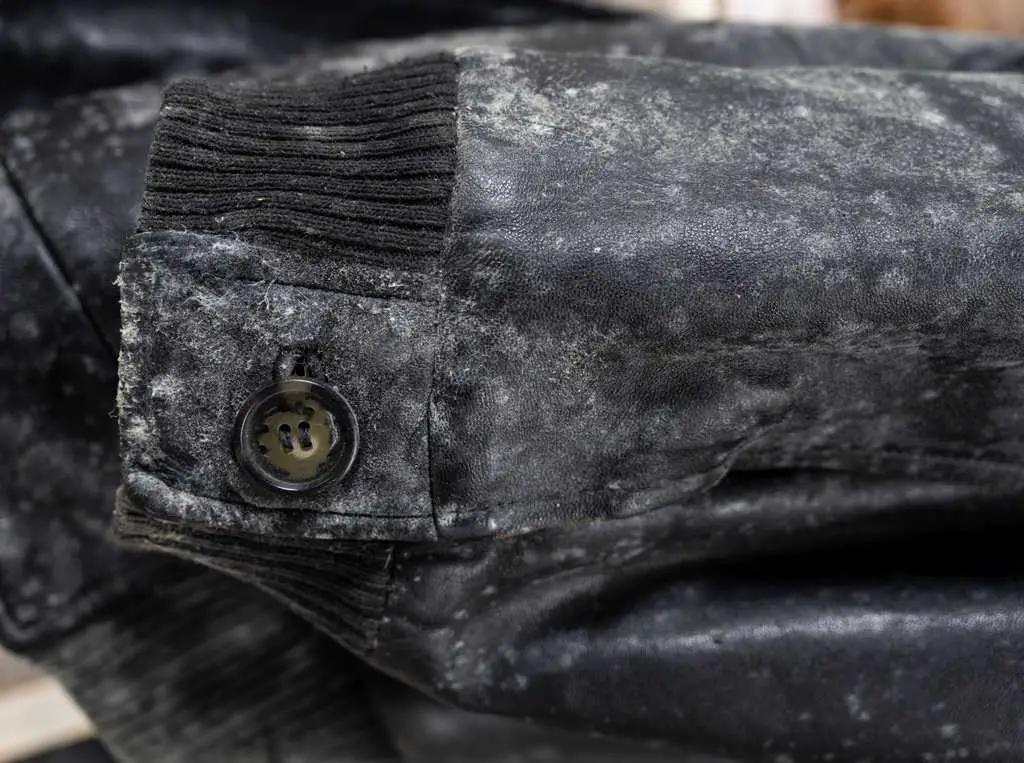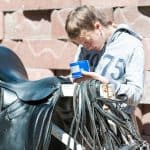If you haven’t used your leather jacket in a while, and you’ve left it in or near a moist area, chances are, mold will start to form. Don’t throw your jacket away though. As disgusting as mold and fungus are, it’s not the end of the world for leather jackets. Here are some of the best ways on how you can safely remove mold from your leather jacket.
How does leather get moldy?
Practically every organic matter can get moldy quite quickly. Leather is very much an organic product, as it is made from animal hide, so it can grow mold easily.
There are specific conditions for mold to be able to grow. Mold cannot grow below 40°F (4.5°C), and they thrive the most at 77-86°F (25-30°C). Another important factor for their growth is moisture. If the environment it is stored in is damp or humid, like near bathrooms.

If you are going to clean your jacket yourself, it is best to wear respiratory protective equipment like a mask and goggles as there are species of mold that can be harmful to humans and can cause severe allergic reactions. To be safe, it is best to protect yourself from breathing in the spores.
How to Prevent Mildew on Leather – Storage tips
Thankfully you don’t need to store your leather jacket in the fridge to prevent mold from forming. It doesn’t take a lot of effort to prevent mold from forming, you just need to keep in mind a few things when storing your leather jacket.
Humidity and ventilation
In order to prevent jackets from forming mold, the storing conditions should be as dry as you can get them. You can lower the humidity by using a dehumidifier in your closet. You can also use a coat storage bag so your jacket is not exposed to moist air.
If you cannot lower the humidity for any reason, then it is best to store your jacket in a well-ventilated area to prevent moisture from condensing on your jacket and instigating mold growth. Air circulation is very good at preventing mold from growing.
Wipe and dry off before storing
Even if you use a storage bag, or put it in a closet that has very low humidity, if you do not wipe off any excess moisture on the jacket, mold can still grow on your jacket. If the leather has absorbed a significant amount of moisture, you should also dry it off properly in an open area as the moisture within the jacket can be enough for the mold to grow.
Take your jacket out every few days
In the most ideal conditions, mold can start to grow and germinate within as soon as 24 hours. If you have done your best to dehumidify the storing area and protect it as much as possible, moisture may still find its way to your jacket and mold will follow suit.
If left for long enough, mold can start to colonize in as much as 5-10 days. To prevent this, it’s best to air your jacket out every few days. Use it if possible, and inspect it for mold growth. If you don’t want to wear it, you can simply hang it in a well-ventilated room. Bright lights and indirect sunlight can also inhibit and kill molds.
How to clean mold from leather jackets
Prevention is always better than having to fix a moldy leather jacket. Sometimes though, it is inevitable to have mildew growth on your jacket. We can forget about our jackets in the closet, have a pipe burst, or have a leaky ceiling that can cause our jackets to be exposed to excess moisture.
Here are some of the best ways to remove and clean fungus off of your leather jacket.
Saddle soap
Saddle soap is an excellent leather cleaning product that is commonly used on hard leather products like shoes, or as it says in the name, saddles. As saddle soap is still a soap, it still has the potential to dry out the leather. It is best to not use it often, as well as to follow it up with conditioner to keep the leather’s moisture intact.
Things you will need:
- Saddle soap
- Horse hair brush dedicated for cleaning only
- Tissue or toilet paper
- Soft cloth
- Clean water
- Mask
- LEATHER CLEANER: This all-in-one leather cleaner and conditioner paste is a must-have for restoring...
- MULTI USE: Ideal for fine saddlery, boots, shoes, and other smooth leather articles, this saddle...
- LEATHER CONDITIONER: Fiebing's Saddle Soap for leather penetrates and lubricates leather fibers,...
Steps:
- Wear your mask to avoid inhaling any airborne spores.
- Lay the jacket on a flat surface you can work on.
- Use a tissue to remove any large colonies and moldy colors that are immediately visible.
- Dab the horse hair brush in a little bit of water and rub it onto the saddle soap.
- Proceed to lather the jacket in circular motions with the brush working in sections.
- Once you are done, remove the excess saddle soap with the soft cloth. Do not use water to rinse the saddle soap off.
- Proceed to the cleaning after-care section below to know what to do after cleaning.
Tips and extra information:
- Saddle soap contains fat that can make your leather jacket more supple. It can also condition the leather, but it shouldn’t be the only thing you do. Make sure to condition the jacket afterward as well.
- Make sure to use the horse hair brush with your saddle soap only. Do not use it to clean dust and debris off your jacket.
- Alternatively, you can use mild soap instead of saddle soap if you do not have access to it. You can create a solution of soapy water, or rub the brush onto the soap after dabbing it in water.
- Do not use hard-bristled brushes as this can scratch the leather. If you do not have access to a horse hair brush, you can use any soft-bristled brush.
Lemon juice
Lemon juice has been considered a natural and non-toxic mold remover for ages now because it is harmless to pets, people, and the environment. It has a 5% acid content, making it perfect for cleaning surfaces without leaving too much acidity on the product. However, because it still contains acid, it is best to avoid overdoing it and leaving it without conditioning afterward.
Things you will need:
- Lemon juice
- Water
- Soft cloth or sponge
- Spray bottle
- Mask
Steps:
- Always wear your mask to prevent breathing in any mold spores.
- Wipe the surface of your leather garment to remove any debris or loose dust.
- Mix 1 cup of water with 1 cup of lemon juice and place it inside the spray bottle. The lemon juice mixture loosens up the accumulated fungal growth, making it easier for you to remove them.
- Spray the lemon juice mixture onto your leather garment that has molds on it.
- Using a sponge or a soft cloth, gently wipe the moldy areas immediately.
- Proceed to the cleaning after-care section below to prevent water stains.
Tips and extra information:
- You can also use an alcohol or white vinegar mixture for removing molds if you don’t have lemon juice at your disposal.
- Alcohol, vinegar, and lemon are all great ways to remove mold not only on the surface but deeper into the fibers as well.
Deep mold removal
If you’ve left your jacket to mold for very long and the mold has left stains and has penetrated the fibers of your jacket, this calls for deeper disinfection, as well as fixing those stains. Mold left for too long can cause permanent damage, but dye can disguise some of that damage.
Things you will need:
- Alcohol
- Leather dye the same color as your jacket or Leather Re-Coloring Balm
- Small sponge
- Soft cloth
- Cotton swab
- Mask
- Tissue or toilet paper
- Spray bottle
- Water
Steps:
- Wear your mask to avoid breathing in mold spores.
- Remove any excess or large mold sections with tissue.
- Mix 1 part alcohol to 1 part water in a spray bottle.
- Spray the alcohol solution onto the leather jacket, making sure to let it penetrate deep into the fibers.
- Dab the sponge with the alcohol mixture onto more concentrated areas.
- Let the jacket dry.
- Once the jacket is dry, you may use a cotton swab or sponge to dab dye onto the discolored areas. Be conservative as the dye is very concentrated and can stain everything around it.
- Take off any excess dye with tissue or absorb it with a sponge.
- Proceed to the cleaning after-care section below.
Tips and extra information:
- Letting the alcohol stay for long periods of time will put your leather jacket at risk. So it is very important to take note of the after-care methods that we will list below.
- If you are not confident in putting dye on yourself, it is best to get the jacket cleaned by a professional and have them re-dye the jacket properly.
Cleaning after-care
The cleaning methods listed above expose the leather to potential damage as cleaning products will strip the protective oils and layers that strengthen and make the leather water resistant. It is always best to condition and waterproof your jacket after using any type of leather cleaner.
Leather conditioner
This is always a must, especially after deep mold removal. Alcohol penetrating the fibers of the leather can lead it to dry out very quickly. Lather on leather conditioner over the entire jacket to ensure its suppleness and give back its moisture.
- CONDITIONS AND RESTORES: The refined water-based formula is blended with Vitamin E and Aloe extracts...
- DRY-TO-THE-TOUCH FORMULA: Once the surface is clean, spread Leather Conditioner with a microfiber...
- RESTORE WITH VITAMIN E & ALOE: Leather Conditioner is designed to maintain coated and natural...
Waxing
This is optional, but if you want to make your leather jacket more water resistant, it is best to use waxes to protect it from water damage . Many leather conditioners have waterproofing features to them, but waxes like beeswax or carnauba can help create a better layer against water. It also helps seal the leather’s moisture in better as well.
- CONDITIONS & RESTORES LEATHER -- Our unique blend of seed oils and triple filtered beeswax provide a...
- PROTECTS LEATHER -- The triple filtered beeswax provides a layer of defense over the leathers...
- Formulated with All Natural Ingredients -- We pride in our All-Natural Leather Cream. Made with...
Conclusion
Mold is not only disgusting, but it is also a health hazard. It is never good to have mold lying around, especially on clothing that gets so close to our noses. On top of that, having mold on leather is also very unsightly. Fortunately, throwing away your leather jacket is not the solution, and there are many ways to fix this issue and disinfect the jacket.
We hope this guide has helped you figure out how to prevent your leather jacket from molding and how you can clean the mold off of it effectively.
FAQ
Can isopropyl alcohol damage leather?
Yes, it can. However, if you use it properly, it can help clean and disinfect the leather very effectively. Make sure not to use it directly on the leather and always use it diluted with water with a soft cloth or sponge. We advise taking caution when it comes to using this chemical since it can dry it out, and if it isn’t conditioned afterward, it may cause the fibers to be brittle and manifest as cracks on your leather item.











